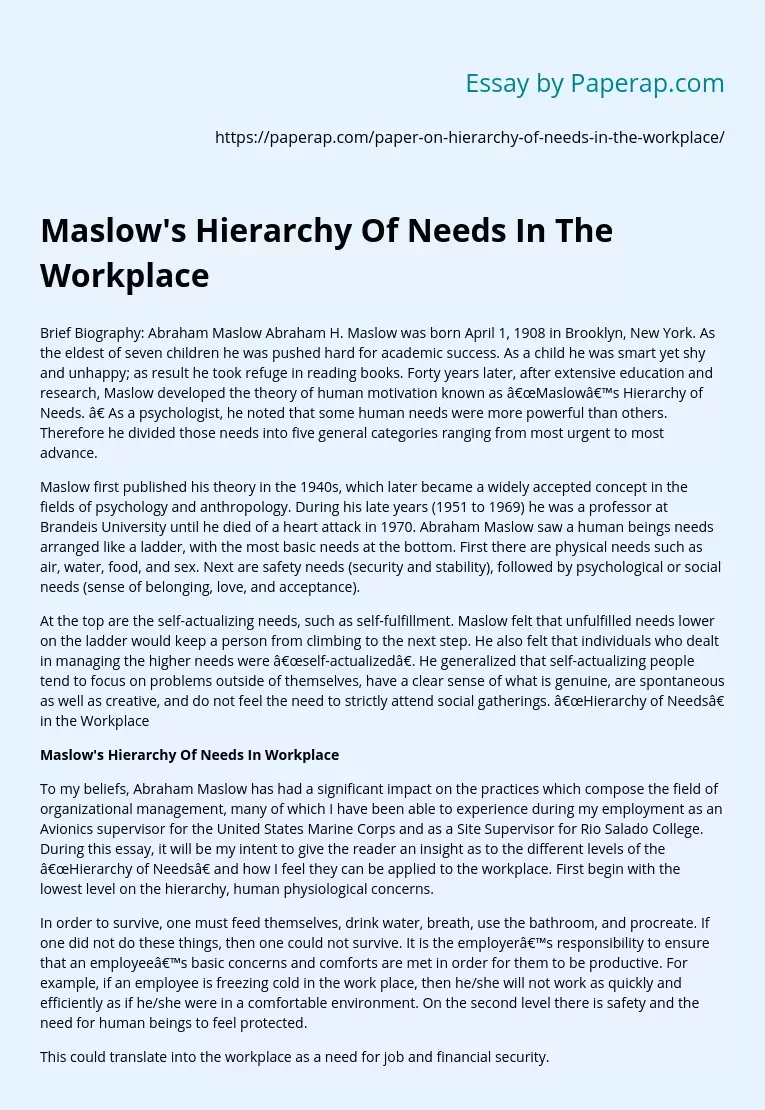Maslow's Hierarchy Of Needs In The Workplace
Brief Biography: Abraham Maslow Abraham H. Maslow was born April 1, 1908 in Brooklyn, New York. As the eldest of seven children he was pushed hard for academic success. As a child he was smart yet shy and unhappy; as result he took refuge in reading books. Forty years later, after extensive education and research, Maslow developed the theory of human motivation known as “Maslow’s Hierarchy of Needs. ” As a psychologist, he noted that some human needs were more powerful than others.
Therefore he divided those needs into five general categories ranging from most urgent to most advance.
Maslow first published his theory in the 1940s, which later became a widely accepted concept in the fields of psychology and anthropology. During his late years (1951 to 1969) he was a professor at Brandeis University until he died of a heart attack in 1970. Abraham Maslow saw a human beings needs arranged like a ladder, with the most basic needs at the bottom. First there are physical needs such as air, water, food, and sex.
Next are safety needs (security and stability), followed by psychological or social needs (sense of belonging, love, and acceptance).
At the top are the self-actualizing needs, such as self-fulfillment. Maslow felt that unfulfilled needs lower on the ladder would keep a person from climbing to the next step. He also felt that individuals who dealt in managing the higher needs were “self-actualized”. He generalized that self-actualizing people tend to focus on problems outside of themselves, have a clear sense of what is genuine, are spontaneous as well as creative, and do not feel the need to strictly attend social gatherings.
“Hierarchy of Needs” in the Workplace
Maslow’s Hierarchy Of Needs In Workplace
To my beliefs, Abraham Maslow has had a significant impact on the practices which compose the field of organizational management, many of which I have been able to experience during my employment as an Avionics supervisor for the United States Marine Corps and as a Site Supervisor for Rio Salado College. During this essay, it will be my intent to give the reader an insight as to the different levels of the “Hierarchy of Needs” and how I feel they can be applied to the workplace. First begin with the lowest level on the hierarchy, human physiological concerns.
In order to survive, one must feed themselves, drink water, breath, use the bathroom, and procreate. If one did not do these things, then one could not survive. It is the employer’s responsibility to ensure that an employee’s basic concerns and comforts are met in order for them to be productive. For example, if an employee is freezing cold in the work place, then he/she will not work as quickly and efficiently as if he/she were in a comfortable environment. On the second level there is safety and the need for human beings to feel protected.
This could translate into the workplace as a need for job and financial security. Once again, it is an employer’s duty to establish this security for the employees. As a consequence for not fulfilling this need, an employee may not work to their fullest potential, especially if they feel that they could most likely be laid off or fired. In a worst case scenario, an employee may decide to give up or even do something to negatively impact the company as an act of revenge. The third level consists of a person’s desire to belong and feel loved.
An employer can help create this environment by establishing camaraderie among employees. There are possible ways for an employer to provide bonding opportunities by scheduling social events or by pairing compatible individuals to work together. Notorious for implementing these types of bonding strategies, are police units, military, as well as any organization where unit cohesion is of the utmost importance. This is primarily because camaraderie, unit morale, and willingness to work together are essential for these organizations to effectively carry out their purpose.
The fourth level illustrates how human beings strive for success, feel strong emotions, and need self-assurance when in a group environment. Take for example how in the work place, ideally when an employee works to gain respect, the better their boost in self-confidence will be. With this principle, an employer should have the drive to create activities outside of work to motivate employees and raise self-esteem, thus raising worker self-reliance and most importantly workplace productivity.
The final and most important level on Maslow’s hierarchy is “self – actualization”, which refers to an accomplished individual’s ability to be creative, solve problems, and deal with feelings of morality. As related to the workplace, this characteristic unquestionably applies to those in supervisory positions. Without “self-actualization” a manager would not have the confidence to lead, resolve concerns, and deal with the ethical issues that commonly arise in the workplace, eventually resulting in the deterioration of unit structure. In the end, an efficient leader is the key o creating a healthy work environment and enhancing organizational effectiveness. References “Abraham Maslow Biography. ” Value Based Management. 23 Aug. 2008 <http://www. valuebasedmanagement. net/leaders_maslow_hierarchy. html>. Huitt, William. Maslow’s hierarchy of needs. Educational Psychology Interactive. 23 Aug. 2008 ;http://chiron. valdosta. edu/whuitt/col/regsys/maslow. html;. Kermally, Sultan. Gurus on Managing People. London: Thorogood Books, 2005. Sirgy, Joseph M. , and Coskun A. Samli. New Dimensions in Marketing/Quality-of-Life Research. Westport: Quorum Books, 1995.
Maslow's Hierarchy Of Needs In The Workplace. (2019, Dec 05). Retrieved from https://paperap.com/paper-on-hierarchy-of-needs-in-the-workplace/

